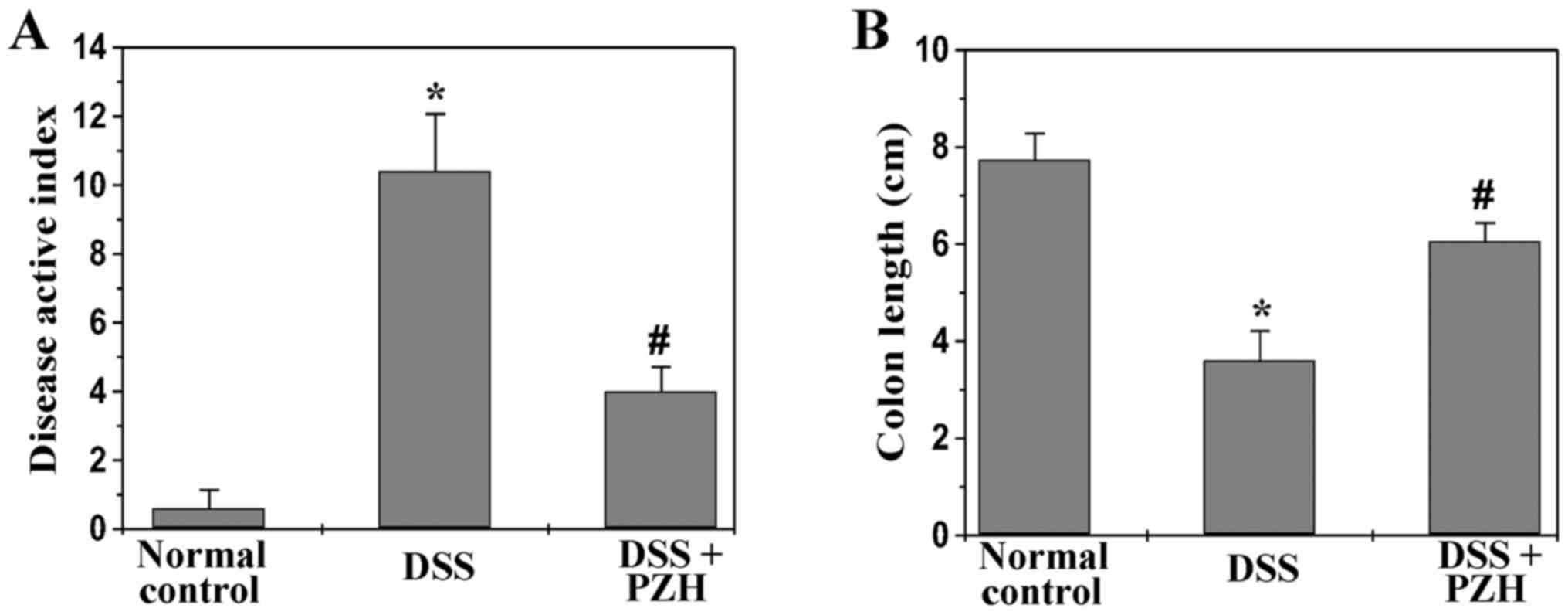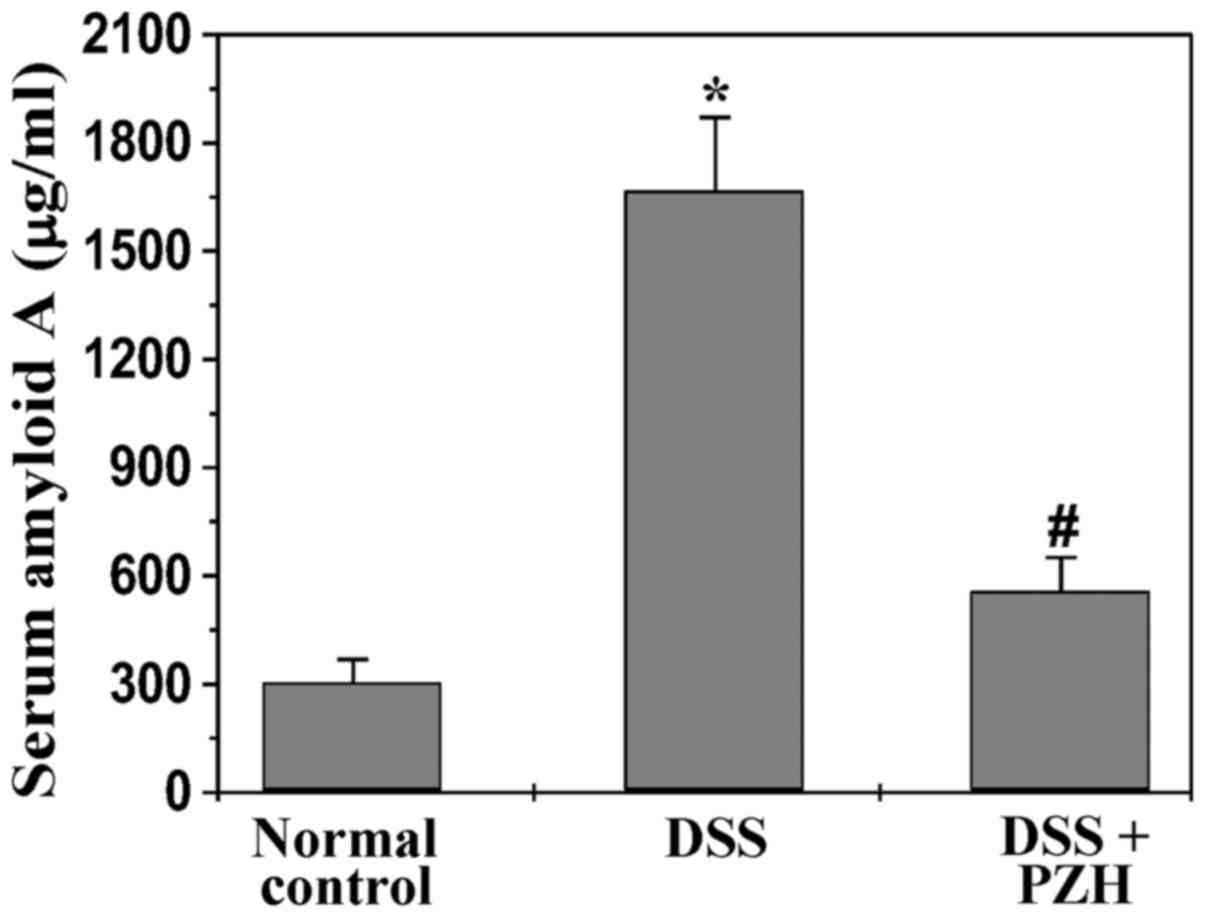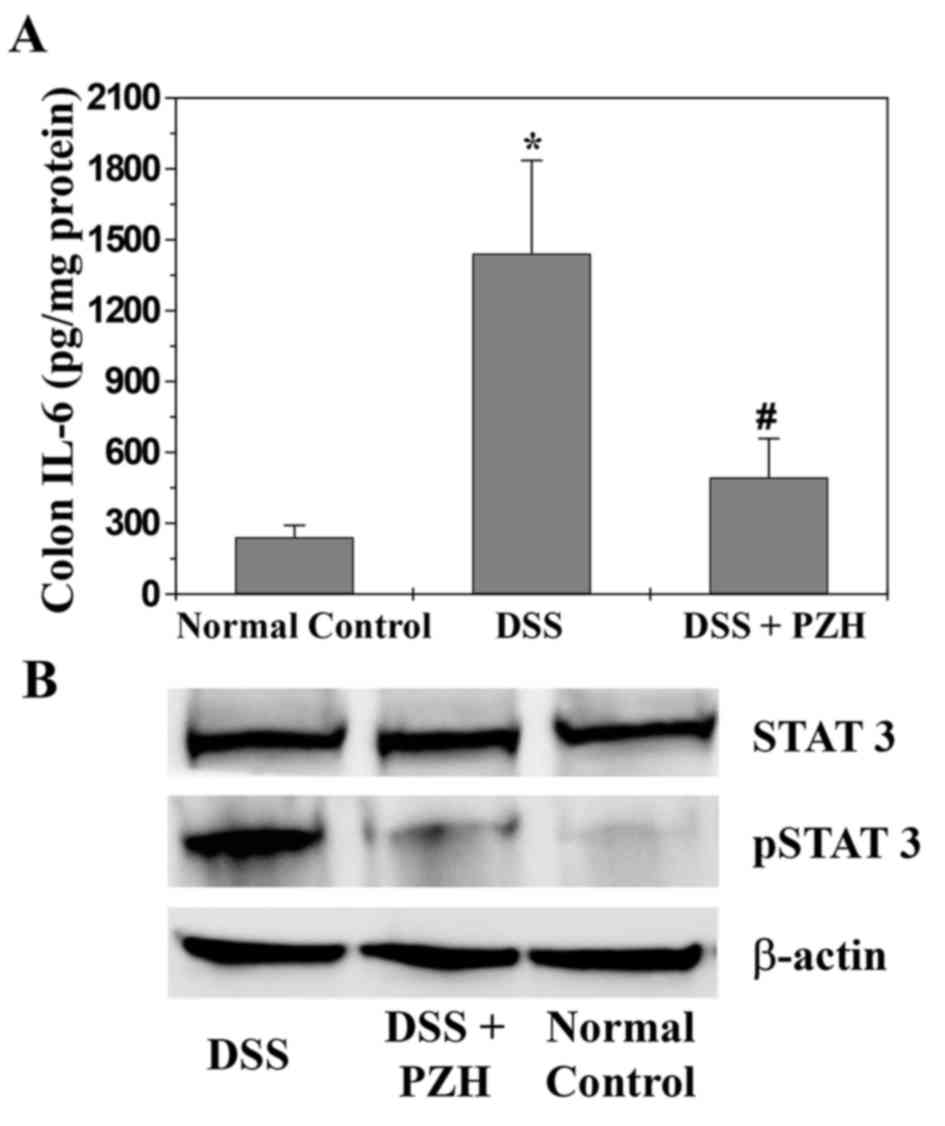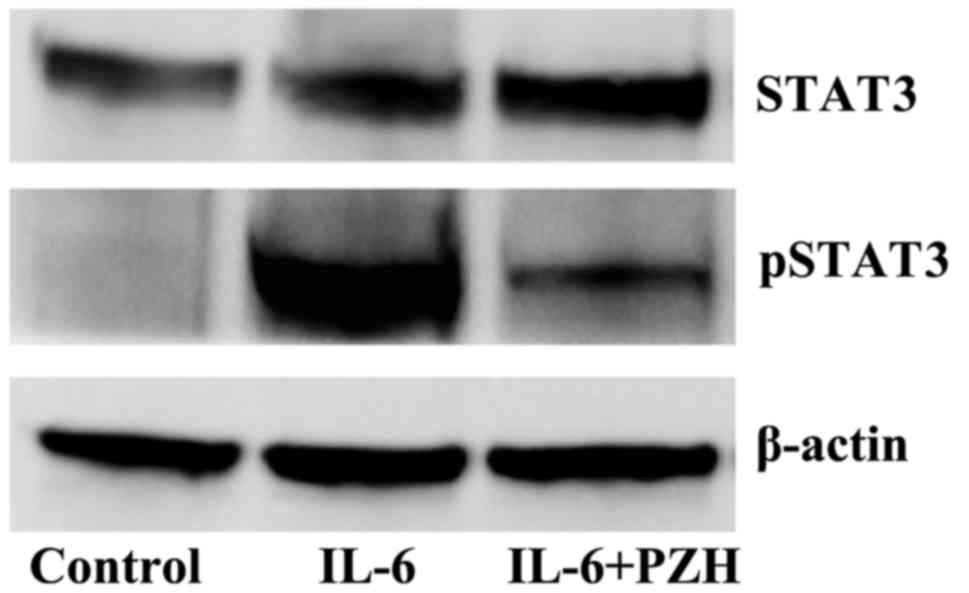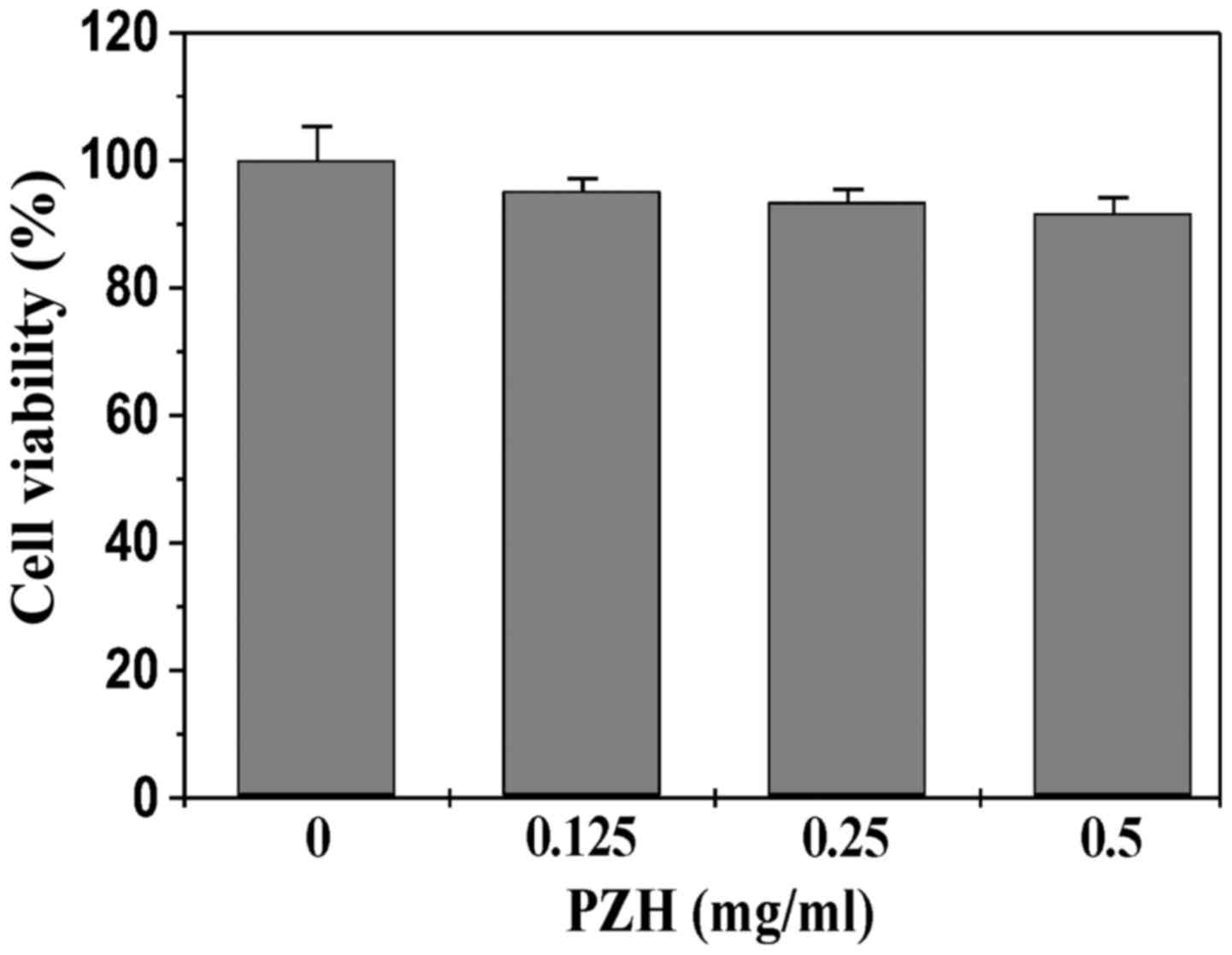Pien Tze Huang ameliorates DSS‑induced colonic inflammation in a mouse colitis model through inhibition of the IL‑6/STAT3 pathway
- Authors:
- Published online on: May 23, 2018 https://doi.org/10.3892/mmr.2018.9051
- Pages: 1113-1119
Abstract
Introduction
Inflammatory bowel disease (IBD), typically referring to ulcerative colitis (UC) and Crohn's disease (CD), is a group of chronically inflammatory disorders of gastrointestinal tract without specific etiology (1–4). Although these inflammatory conditions have been treated with 5-aminosalicylic acid derivatives, corticosteroids and immunosuppressants (5), most of these currently used treatments are inadequate due to severe side effects such as systemic immunosuppression (6–8). Thus, there is a need to develop novel and safer therapeutic agents. Recently, natural product-based treatments, particularly Traditional Chinese Medicine (TCM), have received great interest as they have relatively few side effects and have been used as alternative remedies for a variety of diseases including IBD (9–12).
The pathogenic mechanisms underlying IBD development are complex and heterogeneous, with the involvement of multiple cellular transduction pathways including interleukin-6 (IL-6)/signal transducer and activator of transcription 3 (STAT3) signaling. IL-6 is an important pro-inflammatory cytokine that has been shown to play a potential role in the pathogenesis of IBD. Elevated IL-6 levels have been detected in serum, inflammed colonic mucosal tissues and cultivated lamina propria mononuclear cells in IBD patients (13–16). Moreover, IL-6 level is correlated with the inflammatory severity and therefore is considered as a clinical IBD-relevant parameter (17–23). Previous findings indicated that IL-6 signal transduction in IBD is not mediated by the membrane-bound receptor for IL-6 (IL-6R), but the soluble form of the IL-6R (sIL-6R), a process known as IL-6 trans-signaling (24–26). The IL-6/sIL-6R complex in turn binds to a common signal transducing receptor gp130, promoting dimerization of gp130 and then resulting in activation of the associated Janus kinases (JAKs). Activated JAKs phosphorylate gp130, leading to the recruitment and activation of STAT3 (27). STAT3 is an important transcription factor that plays an essential role in cell survival and proliferation (28,29). After activation via phosphorylation at tyrosine 705 by JAKs, STAT3 proteins in the cytoplasm dimerize and translocate to the nucleus where they regulate the expression of various critical genes, eventually leading to the development of IBD. Constitutive activation of STAT3 has been found in intestinal T cells from IBD patients (21,30) and commonly suggests severe disease activity (31). Therefore, suppressing the IL-6/STAT3 pathway provides a promising therapeutic strategy in IBD.
Pien Tze Huang (PZH) is a well-known TCM formula that was first prescribed by a royal physician more than 450 years ago in the Ming Dynasty. The main ingredients of PZH include Moschus, Calculus bovis, Snake gall and Radix notoginseng. These products together confer PZH properties of heat-clearing and detoxification (32). Since in the TCM system the accumulation of toxic dampness and heat is one of the major causative factors for inflammation and inflammation-related cancer, PZH has been used in China and Southeast Asia for centuries to clinically treat a variety of inflammatory diseases and cancers (33–50). However, the precise mechanism of anti-inflammatory activity of PZH remains largely unclear. Using dextran sulfate sodium (DSS)-induced mouse colitis model, in the present study we evaluated the therapeutic efficacy of PZH against UC and elucidated the possible molecular mechanisms.
Materials and methods
Materials and reagents
Dulbecco's modified Eagle's medium (DMEM), fetal bovine serum (FBS), penicillin-streptomycin, Trypsin-EDTA were obtained from Life Technologies Corporation (Grand Island, NY, USA). A 24-well cell culture insert was purchased from BD Biosciences (Franklin Lakes, NJ, USA). DSS (molecular weight, 40,000 kDa) was purchased from MP Biomedicals (Solon, OH, USA). Antibodies for western blot analysis were obtained from Cell Signaling Technology, Inc. (Danvers, MA, USA). The immunoblot detection system (ECL Plus) and bicinchoninic acid (BCA) protein assay reagent were obtained from Pierce Biotechnology, Inc. (Rockford, IL, USA). Mouse IL-6 or serum amyloid A (SAA) detection ELISA kit was purchased from BioLegend, Inc. (San Diego, CA, USA) or Immunology Consultants Laboratory, Inc. (Portland, OR, USA), respectively. All the other chemicals, unless otherwise stated, were obtained from Sigma Chemicals (St. Louis, MO, USA).
Preparation of PZH
PZH was obtained from and authenticated by the sole manufacturer Zhangzhou Pien Tze Huang Pharmaceutical Co., Ltd. (Zhangzhou, China; Chinese FDA approval no. Z35020242). The stock solution of PZH was prepared by dissolving PZH powder in saline to a concentration of 20 mg/ml, followed by sonication for 30 min. The working concentrations for cell-based experiments were made by diluting the stock solution in the cell culture medium.
Animals
Seven-week-old male BALB/c mice (weight, 20–22 g) were purchased from Shanghai SLAC Laboratory Animal Co., Ltd. (Shanghai, China) and were acclimatized for 1 week before the experiment. Animals were housed individually in a room maintained at 22°C under a 12-h day/night cycle. Food and water were given ad libitum throughout the experiments. The animal experiments conducted in this study were approved by the Animal Care and Use Committee of Fujian University of Traditional Chinese Medicine.
In vivo mouse colitis study
Mouse colitis model was established as we described previously (51). Briefly, acute colitis was induced by administration with 3% DSS in the drinking water for 8 days. On the first day of model construction, the animals were randomly divided into three groups (n=5): The normal control group in which mice received neither DSS stimulation nor PZH treatment; the DSS-induced model or PZH-treated group in which mice received DSS stimulation and were given intra-gastric administration with saline or 234 mg/kg, respectively, daily for 12 days. The progression of colitis was monitored in a blinded manner, including measurement of body weight, evaluation of stool consistency, and presence of rectal bleeding tested by guaiac paper. Disease activity index (DAI) was represented as the sum of scores for weight loss, stool consistency and rectal bleeding (Table I).
Sample preparation
At the end of the experiment, the animals were anaesthetized with Avertin. Blood was collected via right heart ventricle puncture in lightly heparinized syringes and kept on ice. Sera were separated by 5 min centrifugation at 5,000 × g and stored at −80°C prior to the analysis. The colons were excised and length was measured. One portion of each distal colon was cut and fixed in 10% formalin for histological examination. The remainder of each distal colon was snap-frozen in liquid nitrogen and stored at −80°C for further analysis of the tissue IL-6 level and STAT3 phosphorylation. Proteins in frozen colons were extracted using T-PER Tissue Protein Extraction Reagent kit according to the manufacturer's protocol. Protein concentrations were determined by BCA protein assay kit.
Histopathological evaluation
The formalin fixed section of distal colons were processed and stained with hematoxylin and eosin (H&E) and evaluated under light microscopy in a blinded manner by an experienced pathologist.
Measurement of serum SAA level or expression of IL-6 in colon by ELISA
The level of SAA in the sera and the expression of IL-6 in colonic tissues were measured using ELISA kits according to the manufacturer's protocol. Absorbance was read at 450 nm using a microplate reader (model ELX800; BioTek Instruments, Inc., Winooski, VT, USA). All the samples were analyzed in triplicate.
Western blot analysis
Equivalent amounts of protein were resolved in 12% Novex Bis-Tris gel electrophoresis (NuPAGE; Life Technologies Corporation). Proteins were then transferred into nitrocellulose membranes in an iBlot Western Blotting system (Invitrogen, Grand Island, NY, USA). The membranes were blocked for 1 h at room temperature with super SuperBlock® Blocking Buffers (Pierce Biotechnology, Inc.). They were then incubated at 4°C overnight with primary antibodies against p-STAT3 (rabbit, polyclonal, 1:1,000, CST, cat. no. 9131), regular STAT3 (rabbit, polyclonal, 1:1,000, CST, cat. no. 9132)and β-actin (rabbit, polyclonal, 1:2,000, CST, cat. no. 4967) in blocking buffer. After the membranes were washed, they were further incubated with appropriate horseradish anti-rabbit IgG, HRP-linked antibody (1:5,000, CST, cat. no. 7074) for 1 h at room temperature. The membranes were analyzed using enhanced chemiluminescence Plus reagents and scanned with the Storm Scanner (Amersham Pharmacia Biotech, Inc., Piscataway, NJ, USA).
Cell culture
Human colon cancer Caco-2 cells were purchased from the American Type Culture Collection (Rockville, MD, USA). Cells (passages 20–40) were grown in DMEM supplemented with 20% (v/v) FBS, 1,000 mg/l of glucose, 50 U/ml penicillin and 50 µg/ml streptomycin in a 37°C humidified incubator with 5% CO2. Caco-2 cells usually reached confluence 3 days after seeding, and differentiated into enterocyte-like cells 18–20 days post-confluence. To test the effect of PZH on IL-6-induced phosphoralytion of STAT3, we seeded these fully differentiated cells in 24-well biocameral inserts (area, 0.33 µm2; pore size, 0.4 µm insert). On the day of the experiment, the medium was removed and supplemented with 0.5% FBS medium. Differentiated Caco-2 cells (20 days post-confluence) in 24-well biocameral inserts were pre-incubated with 0.5 mg/ml of PZH for 2 h followed by stimulation with 10 ng/ml of IL-6 for 30 min.
Measurement of cell viability by 3-(4,5-dimethylthiazol-2-yl)-2,5-diphenyltetrazolium bromide (MTT) assay
Differentiated Caco-2 cells (20 days post-confluence) in 96-well plates were treated with various concentrations of PZH for 24 h. The cytotoxic effect of PZH on Caco-2 cells was examined by the MTT colorimetric assay. Briefly, MTT (100 µl) (0.5 mg/ml in PBS) was added to each well, and the samples were incubated for an additional 4 h at 37°C. The purple-blue MTT formazan precipitate was dissolved in 100 µl DMSO. The absorbance was measured at 570 nm using a spectrophotometer reader (Model ELX800; BioTek Instruments, Inc., Winooski, VT, USA).
Statistical analysis
Data were presented as mean ± SD for the indicated number of independently performed experiments. The data were analyzed using the SPSS package for Windows (version 17.0; SPSS, Inc., Chicago, IL, USA). Statistical analysis was carried out using Student's t-test and one-way ANOVA, followed by LSD's test or Dunnett's test. Differences with P<0.05 were considered to be statistically significant.
Results
PZH potentially inhibits the development of DSS-induced UC in mice
To determine whether PZH could inhibit the development of UC, we evaluated the clinical manifestations in experimental mice. The DAI was calculated based on the observation of body weight, stool consistency and rectal bleeding. As shown in Fig. 1, upon DSS stimulation mice exhibited apparent manifestations of colitis which was characterized by body weight loss, diarrhea and rectal bleeding. Administration of PZH significantly ameliorated DSS-induced colitis symptoms. The DAI score of normal control, DSS-stimulated model or PZH-treated group was 0.6±0.54, 10.4±1.67 or 4.0±0.71, respectively (P<0.05; Fig. 1A). Moreover, colons were harvested from mice in each group after sacrifice; and length from cecum to anus was measured. We found that PZH treatment profoundly prevented DSS-induced colon shortening. The average colonic length in normal control, model or PZH-treated group was 7.74±0.34, 3.6±0.41 or 6.06±0.38 cm, respectively (P<0.05; Fig. 1B). Taken together, PZH is potent in suppressing the development of UC in vivo.
PZH alleviates colon histological damages in mice with DSS-induced UC
We next evaluated the histopathological changes of colon tissues through H&E staining. As shown in Fig. 2, the normal control mice displayed normal colonic histology with an intact epithelium, well-defined gland lengths and no leukocyte infiltration in the mucosa, whereas DSS induced severe colonic histological damages such as mucosal ulceration, inflammatory cell infiltration, crypt distortion and hyperplastic epithelium. However, PZH treatment significantly alleviated DSS-induced histopathological changes in colonic mucosa.
PZH reduces SAA level in mice with DSS-induced UC
It has been shown that the level of the inflammatory marker SAA is increased in UC patients. We therefore performed ELISA assay to examine SAA level in experimental mice. As shown in Fig. 3, PZH treatment significantly inhibited DSS-induced increase of serum level of SAA in UC mice. The SAA level in mice of normal control, model or PZH-treated group was 304.9±62.8, 1,667.9±202.9 or 558.2±92.5 µg/ml, respectively (P<0.05).
PZH suppresses IL-6/STAT3 signaling pathway both in mice with DSS-induced UC and in inflammatory intestinal epithelial cells
To investigate the mechanism of the anti-inflammatory activity of PZH, we evaluated the activation of IL-6/STAT3 pathway in colon tissues of experimental mice. The protein expression of IL-6 in colon tissues was determined by ELISA assay and STAT3 activation was examined by western blot analysis using antibody that recognizes STAT3 phosphorylation at Tyr705. As shown in Fig. 4, the expression of IL-6 and the phosphorylation level of STAT3 in DSS-induced UC mice was significantly increased, as compared to that in normal control mice; which, however, was significantly inhibited by PZH treatment.
By stimulating the differentiated human colorectal carcinoma Caco-2 cells with IL-6, we generated an inflammatory cell model of human intestinal epithelium to examine the in vitro effect of PZH on IL-6/STAT3 pathway. As shown in Fig. 5, IL-6 stimulation resulted in a significant increase of pSTAT3 level in Caco-2 cells. However, PZH treatment profoundly inhibited IL6-induced STAT3 phosphorylation. The levels of non-phosphorylated STAT3 remained unchanged after the treatment with IL-6 and/or PZH.
PZH did not display cytotoxicity in intestinal epithelial cells
To exclude the possibility that the in vitro suppressive activity of PZH on STAT3 pathway was due to cytoxicity, we determined its effect on the viability of differentiated Caco-2 cells using MTT assay. As shown in Fig. 6, Caco-2 cell viability was not affected by treatment with PZH, suggesting that the inhibitory effect of PZH on IL-6-induced STAT3 activation in intestinal epithelial cells did not result from its cytotoxic action.
Discussion
Despite recent advances in the drug treatment of IBD, many currently used pharmacotherapies contain intrinsic side effects such as systemic immunosuppression, which limits their long-term use (5–8). Natural products, including TCM, have received great interest since they have long been used to clinically treat inflammatory diseases and are relatively toxicity-free (9–12). PZH is a well-known TCM formula which has been used in China and Southeast Asia for centuries to clinically treat a variety of inflammatory diseases (33–50). However, the precise mechanism of anti-inflammatory activity of PZH remains largely unknown.
Using a DSS-induced mouse colitis model, in the present study, we evaluated the therapeutic efficacy of PZH against UC. We found that PZH significantly ameliorated DSS-induced colitis symptoms, including body weight, stool consistency and rectal bleeding. In addition, the administration of PZH profoundly prevented DSS-induced colon shortening, and alleviated colonic histopathological changes such as mucosal ulceration, infiltration of inflammatory cells, crypt distortion and hyperplastic epithelium. Moreover, PZH markedly inhibited the DSS-induced increase in serum levels of SAA, one of the inflammatory biomarkers which is commonly elevated in patients with UC. Thus, PZH is potent in suppressing the development of UC.
The IL-6/STAT3 pathway is an important signaling pathway that mediates inflammatory response. As a critical pro-inflammatory cytokine, IL-6 plays essential roles in the development of inflammatory diseases including IBD. Elevated IL-6 levels have been detected in the serum, inflammed colonic mucosal tissues and cultivated lamina propria mononuclear cells in IBD patients and in murine model with acute inflammation (13–16). In addition, serum IL-6 level is positively correlated with severity of intestinal histopathology (17–23). Generally, IL-6 exerts its bioactivities via binding to the sIL-6R, leading to the activation of JAKs and the downstream effectors such as STAT3 (24–27). Activated STAT3 proteins in the cytoplasm form homodimers and translocate to the nucleus to regulate the expression of various critical genes mediating antiapoptotic activities (28,29). Constitutive activation of STAT3 has been commonly found in lamina propria mononuclear cells from IBD patients, resulting in the resistance against apoptosis in these cells and eventually the progression of IBD (21,30,31). Thus, the IL-6/STAT3 pathway has become a major target in the treatment of IBD. Using ELISA assay we found that PZH treatment significantly inhibited the DSS-induced expression of IL-6 in UC mice. Moreover, the increased phosphorylation of STAT3, induced by DSS in experimental mice or by IL-6 in the differentiated human colorectal carcinoma cells, was profoundly suppressed by PZH.
In conclusion, in the present study we report, to the best of our knowledge, for the first time that PZH attenuates intestinal inflammation in murine colitis model probably through inhibition of the IL-6/STAT3 pathway, demonstrating its potential clinical value in the treatment of IBD.
Acknowledgements
Not applicable.
Funding
This study was supported by the National Natural Science Foundation of China (81673721), the International Cooperative Project of Fujian Department of Science and Technology (2017I0007) and the Natural Science Foundation of Fujian Province (2018J01229).
Availability of data and materials
The datasets used and/or analyzed during the current study are available from the corresponding author on reasonable request.
Authors' contributions
JP and YC conceived and designed the experiments. LL, AS, JC and XK conducted the animal experiments. LL and TJS performed western blot and data analysis. AS and SS conducted ELISA and analysis. LL, JP and YC wrote and revised the manuscript.
Ethics approval and consent to participate
The animal experiments conducted in this study were approved by the Animal Care and Use Committee of Fujian University of Traditional Chinese Medicine.
Consent for publication
Not applicable.
Competing interests
The authors declare that they have no competing interests.
Glossary
Abbreviations
Abbreviations:
|
TCM |
Traditional Chinese Medicine |
|
PZH |
Pien Tze Huang |
|
IBD |
inflammatory bowel disease |
|
UC |
ulcerative colitis |
|
IL-6 |
interleukin-6 |
|
STAT3 |
signal transducer and activator of transcription 3 |
References
|
Baumgart DC and Carding SR: Inflammatory bowel disease: Cause and immunobiology. The Lancet. 369:1627–1640. 2007. View Article : Google Scholar | |
|
Baumgart DC and Sandborn WJ: Inflammatory bowel disease: Clinical aspects and established and evolving therapies. The Lancet. 369:1641–1657. 2007. View Article : Google Scholar | |
|
Xavier RJ and Podolsky DK: Unravelling the pathogenesis of inflammatory bowel disease. Nature. 448:427–434. 2007. View Article : Google Scholar : PubMed/NCBI | |
|
Podolsky DK: Inflammatory bowel disease. N Engl J Med. 347:417–429. 2002. View Article : Google Scholar : PubMed/NCBI | |
|
Rezaie A, Parker RD and Abdollahi M: Oxidative stress and pathogenesis of inflammatory bowel disease: An epiphenomenon or the cause? Dig Dis Sci. 52:2015–2021. 2007. View Article : Google Scholar : PubMed/NCBI | |
|
Cho EJ, Shin JS, Noh YS, Cho YW, Hong SJ, Park JH, Lee JY, Lee JY and Lee KT: Anti-inflammatory effects of methanol extract of Patrinia scabiosaefolia in mice with ulcerative colitis. J Ethnopharmacol. 136:428–435. 2011. View Article : Google Scholar : PubMed/NCBI | |
|
Jani N and Regueiro MD: Medical therapy for ulcerative colitis. Gastroenterol Clin N Am. 31:147–166. 2002. View Article : Google Scholar | |
|
Lakatos PL and Lakatos L: Ulcerative proctitis: A review of pharmacotherapy and management. Expert Opin Pharmacother. 9:741–749. 2008. View Article : Google Scholar : PubMed/NCBI | |
|
Treasure J: Herbal medicine and cancer: An introductory overview. Semin Oncol Nurs. 21:177–1835. 2005. View Article : Google Scholar : PubMed/NCBI | |
|
Stickel F and Schuppan D: Herbal medicine in the treatment of liver diseases. Dig Liver Dis. 39:293–304. 2007. View Article : Google Scholar : PubMed/NCBI | |
|
Langmead L and Rampton DS: Review article: Complementary and alternative therapies for inflammatory bowel disease. Aliment Pharmacol Ther. 23:341–349. 2006. View Article : Google Scholar : PubMed/NCBI | |
|
Bensoussan M, Jovenin N, Garcia B, Vandromme L, Jolly D, Bouché O, Thiéfin G and Cadiot G: Complementary and alternative medicine use by patients with inflammatory bowel disease: Results from a postal survey. Gastroenterol Clin Biol. 30:14–23. 2006. View Article : Google Scholar : PubMed/NCBI | |
|
Gross V, Andus T, Cäsar I, Roth M and Schölmerich J: Evidence for continuous stimulation of interleukin-6 production in Crohn's disease. Gastroenterol. 102:514–519. 1992. View Article : Google Scholar | |
|
Holub M C, Mako E, Devay T, Dank M, Szalai C, Fenyvesi A and Falus A: Increased interleukin-6 levels, interleukin-6 receptor and gp130 expression in peripheral lymphocytes of patients with inflammatory bowel disease. Scand J Gastroenterol Suppl. 228:47–50. 1998.PubMed/NCBI | |
|
Isaacs KL, Sartor RB and Haskill S: Cytokine messenger RNA profiles in inflammatory bowel disease mucosa detected by polymerase chain reaction amplification. Gastroenterol. 103:1587–1595. 1992. View Article : Google Scholar | |
|
Reinecker HC, Steffen M, Witthöft T, Pflüger I, Schreiber S, MacDermott RP and Rädler A: Enhanced secretion of tumour necrosis factor-alpha, IL-6, and IL-1 beta by isolated lamina propria mononuclear cells from patients with ulcerative colitis and Crohn's disease. Clin Exp Immunol. 94:174–181. 1993. View Article : Google Scholar : PubMed/NCBI | |
|
Reinisch W, Gasche C, Tillinger W, Wyatt J, Lichtenberger C, Willheim M, Dejaco C, Waldhör T, Bakos S, Vogelsang H, Gangl A and Lochs H: Clinical relevance of serum interleukin-6 in Crohn's disease: single point measurements, therapy monitoring, and prediction of clinical relapse. Am J Gastroenterol. 94:2156–2164. 1999. View Article : Google Scholar : PubMed/NCBI | |
|
Belaiche J, Van Kemseke C and Louis E: Use of the enteroscope for colo-ileoscopy: Low yield in unexplained lower gastrointestinal bleeding. Endoscopy. 31:298–301. 1999. View Article : Google Scholar : PubMed/NCBI | |
|
Louis E, Belaiche J, van Kemseke C, Franchimont D, deGroote D, Gueenen V and Mary JY: A high serum concentration of interleukin-6 is predictive of relapse in quiescent Crohn's disease. Eur J Gastroenterol Hepatol. 9:939–944. 1997. View Article : Google Scholar : PubMed/NCBI | |
|
Kusugami K, Fukatsu A, Tanimoto M, Shinoda M, Haruta J, Kuroiwa A, Ina K, Kanayama K, Ando T and Matsuura T: Elevation of interleukin-6 in inflammatory bowel disease is macrophage- and epithelial cell-dependent. Digestive Dis Sci. 40:949–959. 1995. View Article : Google Scholar | |
|
Atreya R, Mudter J, Finotto S, Müllberg J, Jostock T, Wirtz S, Schütz M, Bartsch B, Holtmann M, Becker C, et al: Blockade of interleukin 6 trans signaling suppresses T-cell resistance against apoptosis in chronic intestinal inflammation: Evidence in Crohn disease and experimental colitis in vivo. Nat Med. 6:583–588. 2000. View Article : Google Scholar : PubMed/NCBI | |
|
Desreumaux P, Brandt E, Gambiez L, Emilie D, Geboes K, Klein O, Ectors N, Cortot A, Capron M and Colombel JF: Distinct cytokine patterns in early and chronic ileal lesions of Crohn's disease. Gastroenterol. 113:118–126. 1997. View Article : Google Scholar | |
|
Brown KA, Back SJ, Ruchelli ED, Markowitz J, Mascarenhas M, Verma R, Piccoli DA and Baldassano RN: Lamina propria and circulating interleukin-6 in newly diagnosed pediatric inflammatory bowel disease patients. Am J Gastroenterol. 97:2603–2608. 2002. View Article : Google Scholar : PubMed/NCBI | |
|
Becker C, Fantini MC, Schramm C, Lehr HA, Wirtz S, Nikolaev A, Burg J, Strand S, Kiesslich R, Huber S, et al: TGF-beta suppresses tumor progression in colon cancer by inhibition of IL-6 trans-signaling. Immunity. 2:491–501. 2004. View Article : Google Scholar | |
|
Becker C, Fantini MC, Wirtz S, Nikolaev A, Lehr HA, Galle PR, Rose-John S and Neurath MF: IL-6 signaling promotes tumor growth in colorectal cancer. Cell Cycle. 4:217–220. 2005. View Article : Google Scholar : PubMed/NCBI | |
|
Dowdall JF, Winter DC, Andrews E, Laug WE, Wang JH and Redmond HP: Soluble interleukin 6 receptor (sIL-6R) mediates colonic tumor cell adherence to the vascular endothelium: A mechanism for metastatic initiation? J Surg Res. 107:1–6. 2002. View Article : Google Scholar : PubMed/NCBI | |
|
Heinrich PC, Behrmann I, Haan S, Hermanns HM, Müller-Newen G and Schaper F: Principles of interleukin (IL)-6-type cytokine signalling and its regulation. Biochem J. 374:1–20. 2003. View Article : Google Scholar : PubMed/NCBI | |
|
Bromberg J and Darnell JE Jr: The role of STATs in transcriptional control and their impact on cellular function. Oncogene. 19:2468–2473. 2000. View Article : Google Scholar : PubMed/NCBI | |
|
Aggarwal BB, Kunnumakkara AB, Harikumar KB, Gupta SR, Tharakan ST, Koca C, Dey S and Sung B: Signal transducer and activator of transcription-3, inflammation, and cancer: How intimate is the relationship? Ann NY Acad Sci. 1171:59–76. 2009. View Article : Google Scholar : PubMed/NCBI | |
|
Lovato P, Brender C, Agnholt J, Kelsen J, Kaltoft K, Svejgaard A, Eriksen KW, Woetmann A and Ødum N: Constitutive STAT3 activation in intestinal T cells from patients with Crohn's disease. J Biol Chem. 278:16777–16781. 2003. View Article : Google Scholar : PubMed/NCBI | |
|
Suzuki A, Hanada T, Mitsuyama K, Yoshida T, Kamizono S, Hoshino T, Kubo M, Yamashita A, Okabe M, Takeda K, et al: CIS3/SOCS3/SSI3 plays a negative regulatory role in STAT3 activation and intestinal inflammation. J Exp Med. 193:471–481. 2001. View Article : Google Scholar : PubMed/NCBI | |
|
Chinese Pharmacopoeia Commission, . Pharmacopoeia of the People's Republic of China. 1. China Medical Science and Technology Press; Beijing: pp. 573–575. 2010 | |
|
Lin JM, Wei LH, Chen YQ, Liu XX, Hong ZF, Sferra TJ and Peng J: Pien Tze Huang-induced apoptosis in human colon cancer HT-29 cells is associated with regulation of the Bcl-2 family and activation of caspase 3. Chin J Integr Med. 17:685–690. 2011. View Article : Google Scholar : PubMed/NCBI | |
|
Zhuang QC, Hong F, Shen AL, Zheng LP, Zeng JW, Lin W, Chen YQ, Sferra TJ, Hong ZF and Peng J: Pien Tze Huang inhibits tumor cell proliferation and promotes apoptosis via suppressing the STAT3 pathway in colorectal cancer mouse. Int J Oncol. 40:1569–1574. 2012.PubMed/NCBI | |
|
Shen AL, Hong F, Liu LY, Lin JM, Zhuang QC, Hong ZF and Peng J: Effects of Pien Tze Huang on angiogenesis in vivo and in vitro. Chin J Integr Med. 18:431–436. 2012. View Article : Google Scholar : PubMed/NCBI | |
|
Shen A, Hong F, Liu L, Lin J, Wei L, Cai Q, Hong Z and Peng J: Pien Tze Huang inhibits the proliferation of human colon carcinoma cells by arresting G1/S cell cycle progression. Oncol Lett. 4:767–770. 2012. View Article : Google Scholar : PubMed/NCBI | |
|
Shen A, Chen Y, Hong F, Lin J, Wei L, Hong Z, Sferra TJ and Peng J: Pien Tze Huang suppresses IL-6-inducible STAT3 activation in human colon carcinoma cells through induction of SOCS3. Oncol Rep. 28:2125–2130. 2012. View Article : Google Scholar : PubMed/NCBI | |
|
Shen A, Lin J, Chen Y, Lin W, Liu L, Hong Z, Sferra TJ and Peng J: Pien Tze Huang inhibits tumor angiogenesis in a mouse model of colorectal cancer via suppression of multiple cellular pathways. Oncol Rep. 3:1701–1706. 2013. View Article : Google Scholar | |
|
Lin W, Zhuang QC, Zheng LP, Cao ZY, Shen AL, Li QY, Fu CX, Feng JY and Peng J: Pien Tze Huang inhibits liver metastasis by targeting TGF-β signaling in an orthotopic model of colorectal cancer. Oncol Rep. 33:1922–1028. 2015. View Article : Google Scholar : PubMed/NCBI | |
|
Wei L, Chen P, Chen Y, Shen A, Chen H, Lin W, Hong Z, Sferra TJ and Peng J: Pien Tze Huang suppresses the stem-like side population in colorectal cancer cells. Mol Med Rep. 9:261–266. 2014. View Article : Google Scholar : PubMed/NCBI | |
|
Chen HW, Shen AL, Zhang YC, Chen YQ, Lin JM, Lin W, Sferra TJ and Peng J: Pien Tze Huang inhibits hypoxia-induced epithelial-mesenchymal transition in human colon carcinoma cells through suppression of the HIF-1 pathway. Exp Ther Med. 7:1237–1242. 2014. View Article : Google Scholar : PubMed/NCBI | |
|
Shen AL, Lin W, Chen YQ, Liu LL, Chen HW, Zhuang QF, Lin JM, Sferra TJ and Peng J: Pien Tze Huang inhibits metastasis of human colorectal carcinoma cells via modulation of TGF-β1/ZEB/miR-200 signaling network. Int J Oncol. 46:685–690. 2014. View Article : Google Scholar : PubMed/NCBI | |
|
Chen H, Feng J, Zhang Y, Shen A, Chen Y, Lin J, Lin W, Sferra TJ and Peng J: Pien Tze Huang inhibits hypoxia-induced angiogenesis via HIF-1α/VEGF-A pathway in colorectal cancer. Evid Based Complement Alternat Med. 2015:4542792015.PubMed/NCBI | |
|
Shen A, Chen H, Chen Y, Lin J, Lin W, Liu L, Sferra TJ and Peng J: Pien Tze Huang overcomes multidrug resistance and epithelial-mesenchymal transition in human colorectal carcinoma cells via suppression of TGF-β pathway. Evid Based Complement Alternat Med. 2014:6794362014. View Article : Google Scholar : PubMed/NCBI | |
|
Qi F, Wei L, Shen A, Chen Y, Lin J, Chu J, Cai Q, Pan J and Peng J: Pien Tze Huang inhibits the proliferation, and induces the apoptosis and differentiation of colorectal cancer stem cells via suppression of the Notch1 pathway. Oncol Rep. 35:511–517. 2016. View Article : Google Scholar : PubMed/NCBI | |
|
Lin J, Feng J, Jin Y, Yan Z, Lai Z and Peng J: Pien Tze Huang suppresses VEGF-C-mediated lymphangiogenesis in colorectal cancer. Oncol Rep. 36:3568–3576. 2016. View Article : Google Scholar : PubMed/NCBI | |
|
Fu C, Chu J, Shen A, Liu L, Chen H, Lin J, Sferra TJ, Chen Y and Peng J: Pien Tze Huang alleviates 5-fluorouracil-induced intestinal mucositis in CT-26 tumor-bearing mice. Exp Ther Med. 14:2291–2297. 2017. View Article : Google Scholar : PubMed/NCBI | |
|
Chen Z, Shen A, Liu L, Chen Y, Chu J, Cai Q, Qi F, Sferra TJ and Peng J: Pien Tze Huang induces apoptosis and inhibits proliferation of 5-fluorouracil-resistant colorectal carcinoma via increasing miR-22 expression. Exp Ther Med. 14:3533–3540. 2017. View Article : Google Scholar : PubMed/NCBI | |
|
Wan Y, Shen A, Qi F, Chu J, Cai Q, Sferra TJ, Peng J and Chen Y: Pien Tze Huang inhibits the proliferation of colorectal cancer cells by increasing the expression of miR-34c-5p. Exp Ther Med. 14:3901–3907. 2017. View Article : Google Scholar : PubMed/NCBI | |
|
Qi F, Zhou S, Li L, Wei L, Shen A, Liu L, Wang Y and Peng J: Pien Tze Huang inhibits the growth of hepatocellular carcinoma cells by upregulating miR-16 expression. Oncol Lett. 14:8132–8137. 2017.PubMed/NCBI | |
|
Ke X, Zhou F, Gao Y, Xie B, Hu G, Fang W, Peng J, Chen Y and Sferra T: Qing Hua Chang Yin exerts therapeutic effects against ulcerative colitis through the inhibition of the TLR4/TNF-κB pathway. Int J Mol Med. 32:926–930. 2013. View Article : Google Scholar : PubMed/NCBI |



